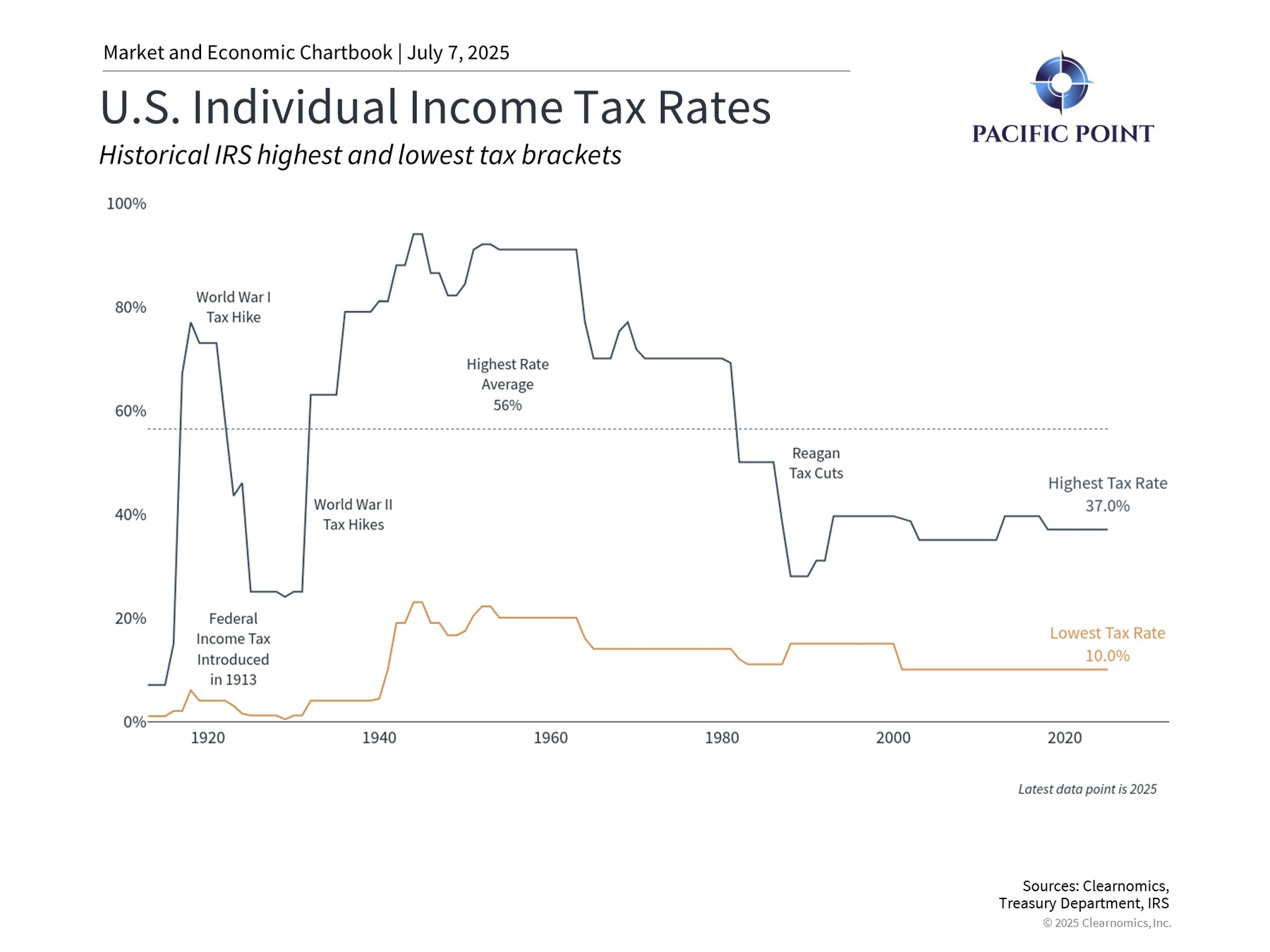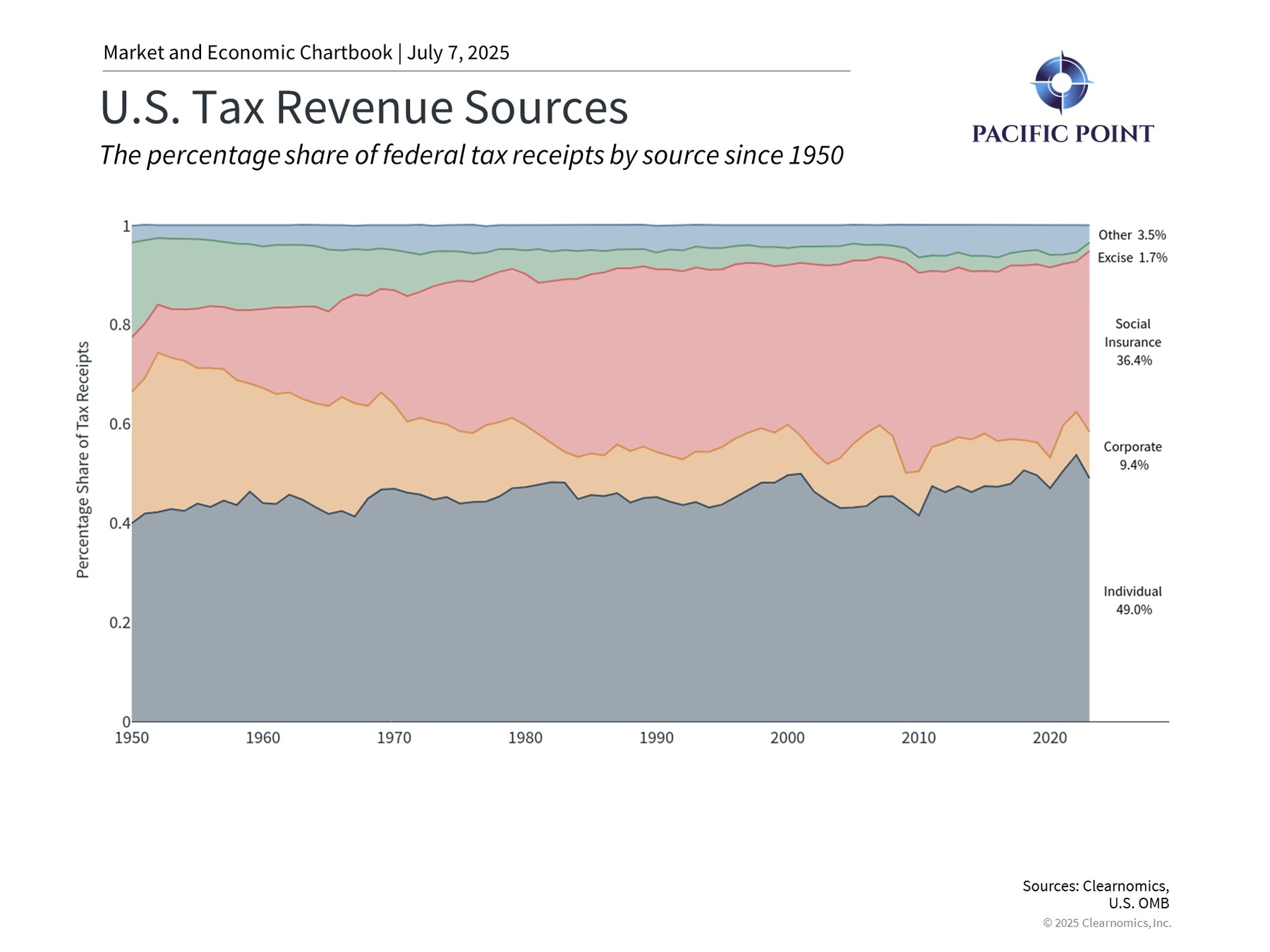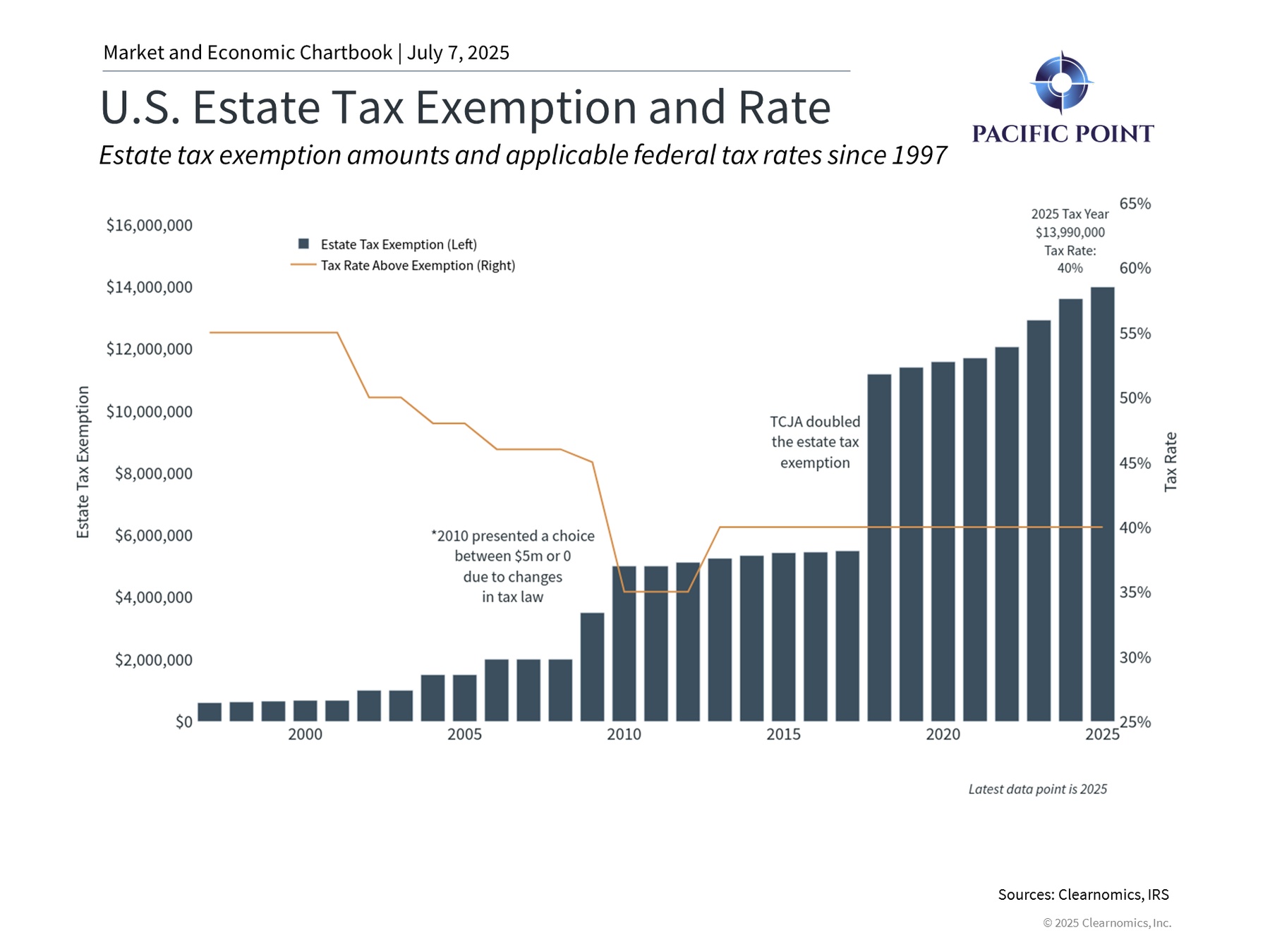Following extensive legislative discussions, Congress has enacted and President Trump has signed comprehensive tax and spending legislation on July 4. This sweeping budget measure
encompasses numerous provisions, including the permanent extension of various Tax Cuts and Jobs Act components, increased state and local tax deduction limits, continued estate tax
exemption levels, and additional measures. The legislation seeks to balance these tax benefits
through targeted spending reductions, particularly in areas like Medicaid.
This legislation holds significance because, although trade policy has dominated recent headlines, fiscal policy uncertainty in Washington has been mounting for years. Despite political divisions regarding this budget’s direction, it eliminates the threat of a “tax cliff” scenario where tax provisions could have undergone dramatic changes upon expiration at year-end.
For individuals, taxation directly influences numerous financial planning considerations, and this bill’s specific measures carry immediate consequences for household budgets. From an economic standpoint, many investors remain concerned about government expenditure levels, escalating national debt, and related factors that have influenced markets over recent decades.
Therefore, this recently enacted budget can be examined from multiple perspectives. What should investors understand regarding their personal financial strategies and the implications for markets moving forward?
Tax Cuts and Jobs Act provisions become permanently established
This new tax legislation, termed the “One Big Beautiful Bill” by the current administration, makes permanent and enhances several critical elements from the 2017 Tax Cuts and Jobs Act (TCJA) that faced expiration. Additionally, it introduces fresh provisions offering taxpayer benefits, which are only partially balanced by expenditure reductions elsewhere. Below
are key provisions potentially affecting households:
- TCJA tax rates and brackets receive permanent status. These were initially scheduled to sunset at 2025’s conclusion.
- Standard deduction amounts rise to $15,750 for individual filers and $31,500 for married couples filing jointly in 2025.
- An additional $6,000 deduction becomes available for eligible seniors (often called a “senior bonus”) with phase-outs beginning at $75,000 gross income. This provision concludes in 2028.
- Alternative minimum tax exemption gains permanent status. Phase-out thresholds also increase to $500,000 for individual filers, with future inflation indexing.
- Child tax credit expands from $2,000 to $2,200 per child, with subsequent inflation adjustments to preserve purchasing power.
- State and local tax (SALT) deduction ceiling rises to $40,000 from the previous $10,000 cap, with 1% annual increases through 2029. It returns to $10,000 in 2030. Phaseouts for higher deductions for households begins at $500,000 of income.
- Tip income deduction up to $25,000 annually for workers earning under $150,000, effective until 2028.
- Certain green energy tax credits face elimination, including electric vehicle and residential energy efficiency incentives.
- Federal debt ceiling increases by $5 trillion. This prevents Congressional debt limit
debates for an extended period, reducing political uncertainty. - The 20% QBI deduction for pass-through entities (sole proprietors, partnerships, S corps, REITS) is now permanent.
- Business provisions expand tax incentives aimed at promoting domestic investment and employment growth.
These modifications, along with numerous others, preserve the relatively modest tax environment characterizing recent decades. The accompanying chart demonstrates that current rates remain substantially below 20th century peaks, when top marginal rates surpassed 70% and occasionally exceeded 90% during wartime.
Mounting fiscal deficit concerns
Tax policy and government deficits represent interconnected fiscal elements. Tax reductions decrease government revenues, requiring compensation through either reduced expenditures or increased borrowing. Nevertheless, most government
spending supports entitlement and defense programs that prove politically challenging
to modify. Treasury Department data indicates that 2025 government spending allocates 21% to Social Security, 14% to Medicare, 13% to National Defense, and 14% to interest payments on existing national debt.
Consequently, government borrowing has grown consistently throughout the past century and will likely continue this trajectory. The Congressional Budget Office, a nonpartisan Congressional support agency, projects this new tax and spending legislation will contribute $3.4 trillion to national debt over the coming decade. This occurs against a federal debt backdrop already exceeding 120% of GDP, totaling $36.2 trillion, or approximately $106,000 per American citizen.
Regrettably, this challenge lacks straightforward solutions, particularly given its contentious
political nature. Tax reductions can potentially stimulate economic growth, potentially offsetting revenue losses through enhanced economic activity. Conversely, Washington demonstrates a poor historical record of budget balancing even during economic strength. The most recent balanced budgets occurred 25 years ago during the Clinton presidency, with the previous occurrence 56 years earlier under the Johnson administration.
It’s crucial to recognize that income taxation hasn’t always existed in the United States. The
contemporary income tax system originated with the 16th Amendment in 1913, initially applying modest rates to relatively few Americans. The system expanded dramatically during the Great Depression and World War II, with peak rates reaching 94% by 1944. The post-war era brought various reforms, including President Reagan’s Tax Reform Act of 1986, which simplified the tax code and reduced rates.
Circumstances have transformed significantly in subsequent years. The accompanying chart illustrates that individual income taxes now constitute the federal government’s primary revenue source. Social insurance taxes, or payroll taxes, are deducted from wages to fund Social Security, Medicare, unemployment insurance, and similar programs. Other revenue sources remain proportionally smaller, including corporate taxes reduced by the TCJA, and excise taxes such as tariffs.
For investors, tax policies undoubtedly carry direct implications for financial plans and portfolios. From a macroeconomic perspective, however, fiscal consequences have more constrained effects. Over extended periods, elevated debt levels can influence interest rates and inflation expectations. While these factors have been relatively elevated recently, many worst-case scenarios have not materialized. The essential approach for long-term investors involves maintaining diversified portfolios capable of performing across various fiscal and economic environments, rather than reacting solely to policy modifications.
Legislation maintains elevated estate tax exemption thresholds
Among the provisions that would have been central to a tax cliff scenario are estate tax exemptions. The TCJA doubled these limits, which were scheduled to return to previous levels this year. However, the new tax bill’s passage makes these higher exemptions permanent, further raising the threshold to $15 million for individuals and $30 million for couples in 2026.
While estate taxes may appear to affect only higher net worth households, the reality is that all families must consider asset transfer strategies to future generations. This requires a comprehensive approach integrating estate planning, tax efficiency, philanthropy, and long-term family wealth preservation objectives. It’s also important to remember that individual states may impose estate taxes with exemption thresholds less favorable than federal levels.
The bottom line? This new spending and tax legislation extends and enhances the current low-tax environment. For investors, a well-constructed financial plan incorporates these tax provisions appropriately. Regarding increasing deficits and national debt, it’s crucial to avoid portfolio reactions and maintain a long-term investment perspective.
Copyright (c) 2025 Clearnomics, Inc. All rights reserved. The information contained herein has
been obtained from sources believed to be reliable, but is not necessarily complete and its
accuracy cannot be guaranteed. No representation or warranty, express or implied, is made as to the fairness, accuracy, completeness, or correctness of the information and opinions contained herein. The views and the other information provided are subject to change without notice. All reports posted on or via www.clearnomics.com or any affiliated websites, applications, or services are issued without regard to the specific investment objectives, financial situation, or particular needs of any specific recipient and are not to be construed as a solicitation or an offer to buy or sell any securities or related financial instruments. Past performance is not necessarily a guide to future results. Company fundamentals and earnings may be mentioned occasionally, but should not be construed as a recommendation to buy, sell, or hold the company’s stock. Predictions, forecasts, and estimates for any and all markets should not be construed as recommendations to buy, sell, or hold any security–including mutual funds, futures contracts, and exchange traded funds, or any similar instruments. The text, images, and other materials contained or displayed in this report are proprietary to Clearnomics, Inc. and constitute valuable intellectual property. All unauthorized reproduction or other use of material from Clearnomics, Inc. shall be deemed willful infringement(s) of this copyright and other proprietary and intellectual property rights, including but not limited to, rights of privacy. Clearnomics, Inc. expressly reserves all rights in connection with its intellectual property, including without limitation the right to block the transfer of its products and services and/or to track usage thereof, through electronic tracking technology, and all other lawful means, now known or hereafter devised. Clearnomics, Inc. reserves the right, without further notice, to pursue to the fullest extent allowed by the law any and all criminal and civil remedies for the violation of its rights.





